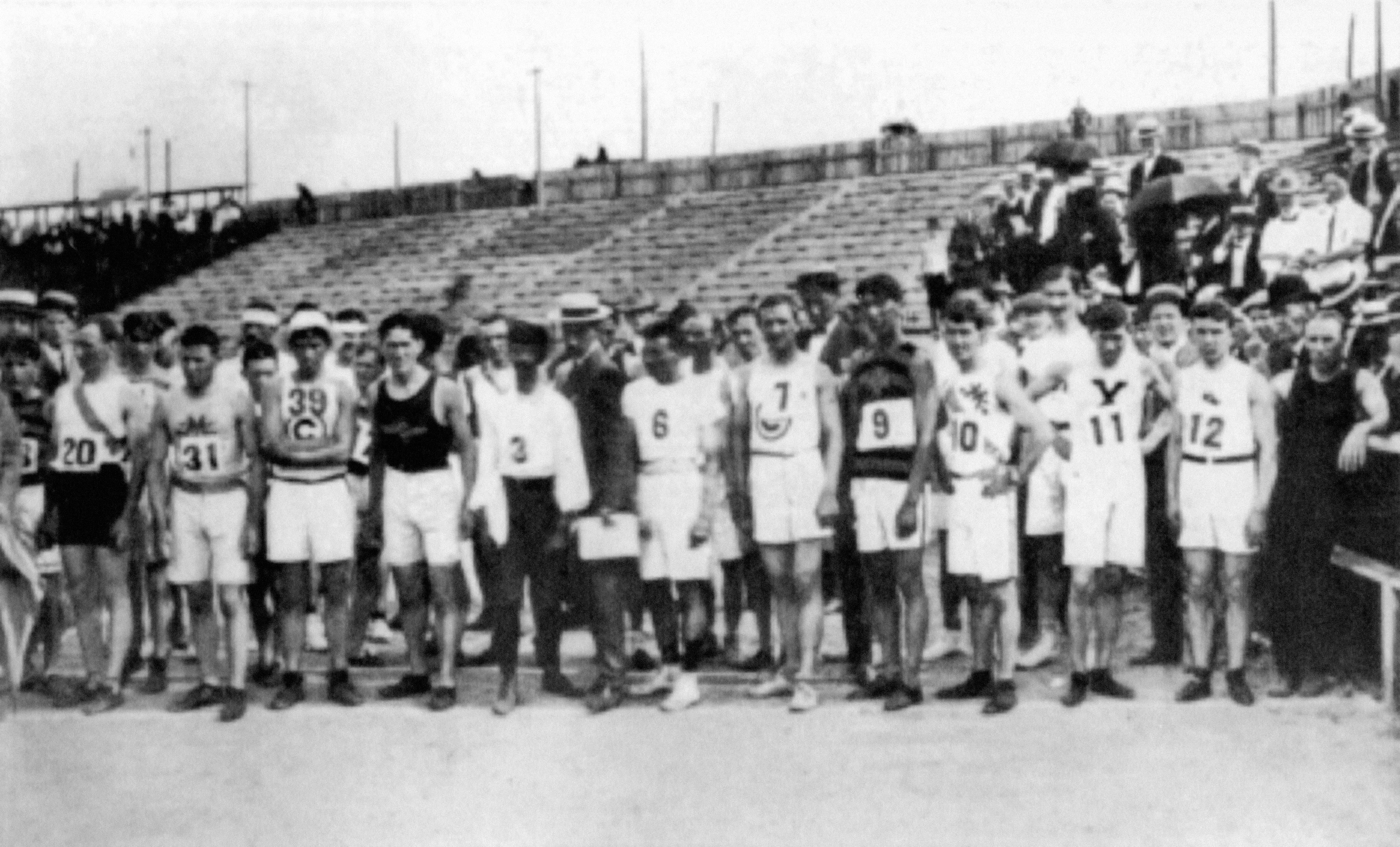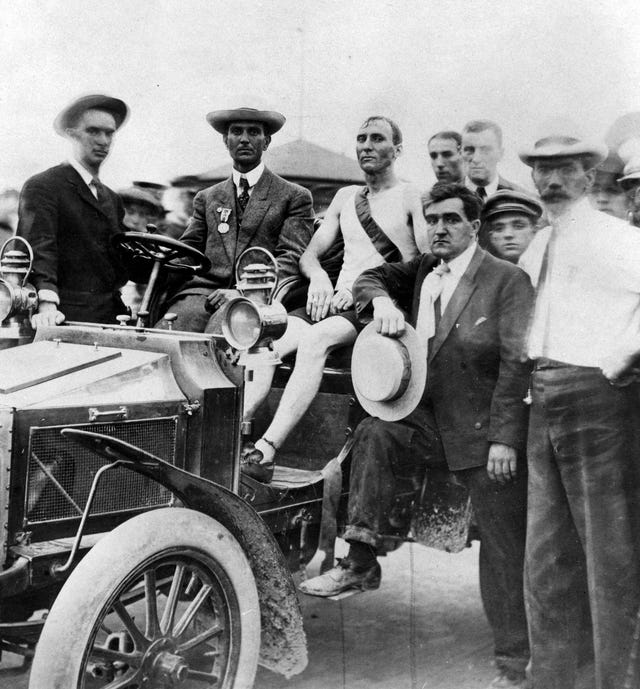
The only event on day 2 of the track and field events was the marathon. This was the most prestigious event of the Olympics, and it turned out to be the most memorable. There were 10,000 spectators in the stands of the stadium. 32 runners from 4 nations were competing, although many had never even ran a marathon before. It was extremely hot on the day of the marathon. The marathon began at 3:00 pm when it was 90 degrees.

Marathon starting line
The athletes ran 5 laps around the stadium track to give the crowd time to observe them before they exited the arena to continue.

Initial marathon laps
From there, things fell apart. For one, the course was incredibly dusty. This was made worse by vehicles which were used by race officials to accompany the runners, making it difficult for the athletes to breathe.

Race officials
Two men from South Africa, Len Tau and Jan Mashiani, competed. Both ran the course barefoot, and Tau ended up being chased about a mile off course by a dog.
/https://tf-cmsv2-smithsonianmag-media.s3.amazonaws.com/filer_public/c5/78/c57851d3-a63d-4bb9-975a-d7216a27a121/4096px-1904_olympic_marathon_participants_len_tau_left_and_jan_mashiani_of_the_tswana_tribe_of_south_africa.jpg)
Len Tau and Jan Mashiani
Another athlete, Felix Carbajal from Cuba, raised funs to finance his trip to the Olympics by showcasing his running skills throughout Cuba. After he arrived in New Orleans, he gambled and lost all of his money. He was forced to walk and hitchhike to St. Louis. He showed up to the marathon in a dress shirt, slacks, leather shoes, and a beret. Other runners helped him cut his pants into shorts with scissors before the race started. Carbajal may have been the best runner in terms of his physical condition. However, he stopped running to chat with spectators, which cost him about an hour total.

Felix Carbajal
The first person to drop out of the race was a top American runner named John Lorden. He started vomiting and left the race. Several other runners developed intense cramps and dropped out, as well. A man named William Garcia collapsed on the side of the road. Race officials took him to the emergency hospital where they discovered he had a stomach hemorrhage. It's said that if Garcia had kept running for much longer, he would have bled to death.
During the 1904 Olympic marathon, race officials were allowed to coach and assist runners. One athlete named Thomas Hicks ended up pretty far in the lead but wasn't doing well and was in a state of exhaustion. When he was 7 miles from the finish line, which was back at the stadium, he was given strychnine, a type of poison, by race officials. This wasn't uncommon for the time; strychnine was thought to serve as a performance enhancer and stimulant in the early 20th century. Hicks begged for water, but none was available. This is because James Sullivan was interested in "purposeful dehydration" research, and therefore, there was only one water station on the marathon course. Hicks asked to lie down but was also refused.

/https://tf-cmsv2-smithsonianmag-media.s3.amazonaws.com/filer_public/92/c6/92c61c9c-55a4-4d79-8b67-0f75aae5dae5/4096px-thomas_j_hicks_of_cambridge_massachusetts_ymca_leading_the_1904_olympic_marathon_runners_at_the_20_mile_mark.jpg)
Thomas Hicks
Hicks eventually slowed to a walk, but he was suddenly passed by a man named Fred Lorz, who looked energized. It turns out that Lorz had been riding in a race official's car for several miles while recovering from cramps. He then got out of the car to continue running. Officials ordered him off the course, but Lorz claimed that the car had broken down and he was just running to get back to the stadium, not actually racing. Officials ignored him as he continued to run.

Fred Lorz
As Lorz approached the stadium in the lead, the spectators began to cheer for him. Lorz ran into the stadium and finished the final stadium lap. The crowd hailed Lorz as the marathon winner. While Lorz was fooling the crowd, Hicks was still plodding along despite suffering from intense fatigue and dehydration. His face lost its color and turned a pale gray. At this point, race officials gave him another dose of strychnine, two egg yolks, and a swig of brandy. While this was happening, Lorz's hoax was exposed and the audience waited for the true marathon winner.
Hicks barely made it to the finish. Officials took Hicks to the box of David Francis to receive his trophy, but Hicks was too weak to accept it. He was taken in for an examination and it was discovered that he had lost 8 pounds while running the marathon. Having achieved his goal of running a marathon, Hicks retired from running.

Hicks in race officials' car after winning
After the conclusion of the marathon, James Sullivan was unamused by Lorz's antics and banned him from amateur competition for life. Lorz said he was innocent and denied intentional deception. A few months later, the AAU rescinded the ban and reinstated his amateur status. In 1905, he won the Boston Marathon.

The Courier-Journal. Aug 31, 1904
As for Hicks, not only was his given drugs, but photos showed him receiving physical assistance, as well. He was seen jogging between two officials who supported Hicks to keep him from collapsing.

Hicks receiving assistance from race officials
In the end, William Garcia nearly died, 18 out of 32 athletes didn't finish, and the winner barely finished and was given help in the form of dangerous stimulants and physical assistance. Many, including James Sullivan, thought the marathon was too dangerous and wanted to get rid of it as an Olympic event.